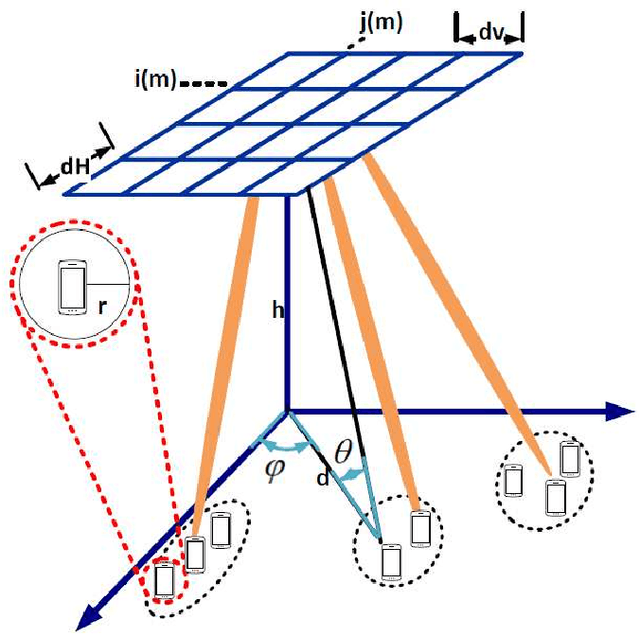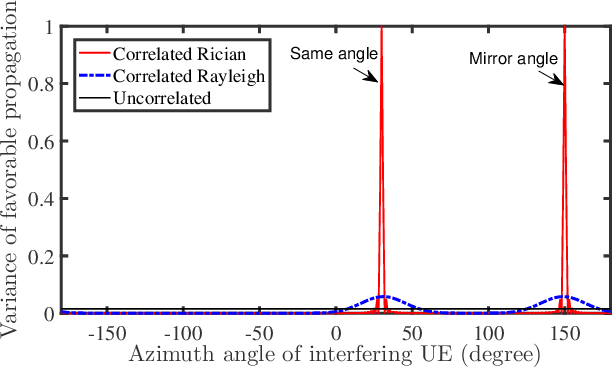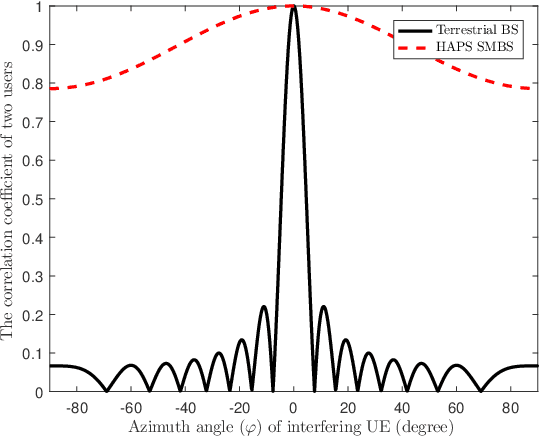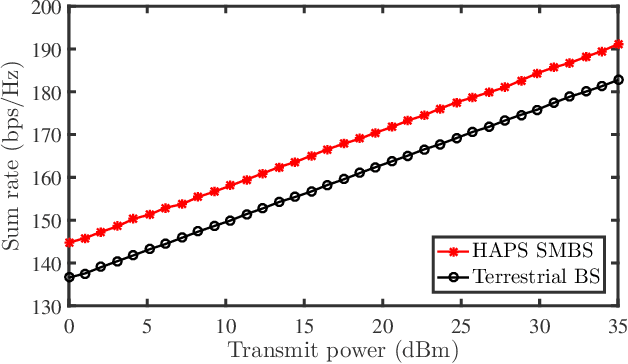Omid Abbasi
MIMO-NOMA Enabled Sectorized Cylindrical Massive Antenna Array for HAPS with Spatially Correlated Channels
Jun 30, 2024Abstract:The high altitude platform station (HAPS) technology is garnering significant interest as a viable technology for serving as base stations in communication networks. However, HAPS faces the challenge of high spatial correlation among adjacent users' channel gains which is due to the dominant line-of-sight (LoS) path between HAPS and terrestrial users. Furthermore, there is a spatial correlation among antenna elements of HAPS that depends on the propagation environment and the distance between elements of the antenna array. This paper presents an antenna architecture for HAPS and considers the mentioned issues by characterizing the channel gain and the spatial correlation matrix of the HAPS. We propose a cylindrical antenna for HAPS that utilizes vertical uniform linear array (ULA) sectors. Moreover, to address the issue of high spatial correlation among users, the non-orthogonal multiple access (NOMA) clustering method is proposed. An algorithm is also developed to allocate power among users to maximize both spectral efficiency and energy efficiency while meeting quality of service (QoS) and successive interference cancellation (SIC) conditions. Finally, simulation results indicate that the spatial correlation has a significant impact on spectral efficiency and energy efficiency in multiple antenna HAPS systems.
A VHetNet-Enabled Asynchronous Federated Learning-Based Anomaly Detection Framework for Ubiquitous IoT
Mar 06, 2023Abstract:Anomaly detection for the Internet of Things (IoT) is a major intelligent service required by many fields, including intrusion detection, device-activity analysis, and security supervision. However, the heterogeneous distribution of data and resource-constrained end nodes present challenges for existing anomaly detection models. Due to the advantages of flexible deployment and multi-dimensional resources, high altitude platform stations (HAPSs) and unmanned aerial vehicles (UAVs), which are important components of vertical heterogeneous networks (VHetNets), have significant potential for sensing, computing, storage, and communication applications in ubiquitous IoT systems. In this paper, we propose a novel VHetNet-enabled asynchronous federated learning (AFL) framework to enable decentralized UAVs to collaboratively train a global anomaly detection model. In the VHetNet-enabled AFL framework, a HAPS operates as a central aerial server, and the local models trained in UAVs are uploaded to the HAPS for global aggregation due to its wide coverage and strong storage and computation capabilities. We introduce a UAV selection strategy into the AFL framework to prevent UAVs with low local model quality and large energy consumption from affecting the learning efficiency and detection accuracy of the global model. To ensure the security of transmissions between UAVs and the HAPS, we add designed noise to local model parameters in UAVs to achieve differential privacy. Moreover, we propose a compound-action actor-critic (CA2C)-based joint device association, UAV selection, and UAV trajectory planning algorithm to further enhance the overall federated execution efficiency and detection model accuracy. Extensive experimental evaluation on a real-world dataset demonstrates that the proposed algorithm can achieve high detection accuracy with short federated execution time and low energy consumption.
FLSTRA: Federated Learning in Stratosphere
Feb 01, 2023Abstract:We propose a federated learning (FL) in stratosphere (FLSTRA) system, where a high altitude platform station (HAPS) felicitates a large number of terrestrial clients to collaboratively learn a global model without sharing the training data. FLSTRA overcomes the challenges faced by FL in terrestrial networks, such as slow convergence and high communication delay due to limited client participation and multi-hop communications. HAPS leverages its altitude and size to allow the participation of more clients with line-of-sight (LoS) links and the placement of a powerful server. However, handling many clients at once introduces computing and transmission delays. Thus, we aim to obtain a delay-accuracy trade-off for FLSTRA. Specifically, we first develop a joint client selection and resource allocation algorithm for uplink and downlink to minimize the FL delay subject to the energy and quality-of-service (QoS) constraints. Second, we propose a communication and computation resource-aware (CCRA-FL) algorithm to achieve the target FL accuracy while deriving an upper bound for its convergence rate. The formulated problem is non-convex; thus, we propose an iterative algorithm to solve it. Simulation results demonstrate the effectiveness of the proposed FLSTRA system, compared to terrestrial benchmarks, in terms of FL delay and accuracy.
HAPS for 6G Networks: Potential Use Cases, Open Challenges, and Possible Solutions
Jan 21, 2023



Abstract:High altitude platform station (HAPS), which is deployed in the stratosphere at an altitude of 20-50 kilometres, has attracted much attention in recent years due to their large footprint, line-of-sight links, and fixed position relative to the Earth. Compared with existing network infrastructure, HAPS has a much larger coverage area than terrestrial base stations and is much closer than satellites to the ground users. Besides small-cells and macro-cells, a HAPS can offer one mega-cell, which can complement legacy networks in 6G and beyond wireless systems. This paper explores potential use cases and discusses relevant open challenges of integrating HAPS into legacy networks, while also suggesting some solutions to these challenges. The cumulative density functions of spectral efficiency of the integrated network and cell-edge users are studied and compared with terrestrial network. The results show the capacity gains achieved by the integrated network are beneficial to cell-edge users. Furthermore, the advantages of a HAPS for backhauling aerial base stations are demonstrated by the simulation results.
VHetNets for AI and AI for VHetNets: An Anomaly Detection Case Study for Ubiquitous IoT
Oct 14, 2022



Abstract:Vertical heterogenous networks (VHetNets) and artificial intelligence (AI) play critical roles in 6G and beyond networks. This article presents an AI-native VHetNets architecture to enable the synergy of VHetNets and AI, thereby supporting varieties of AI services while facilitating automatic and intelligent network management. Anomaly detection in Internet of Things (IoT) is a major AI service required by many fields, including intrusion detection, state monitoring, device-activity analysis, security supervision and so on. Conventional anomaly detection technologies mainly consider the anomaly detection as a standalone service that is independent of any other network management functionalities, which cannot be used directly in ubiquitous IoT due to the resource constrained end nodes and decentralized data distribution. In this article, we develop an AI-native VHetNets-enabled framework to provide the anomaly detection service for ubiquitous IoT, whose implementation is assisted by intelligent network management functionalities. We first discuss the possibilities of VHetNets used for distributed AI model training to provide anomaly detection service for ubiquitous IoT, i.e., VHetNets for AI. After that, we study the application of AI approaches in helping provide automatic and intelligent network management functionalities for VHetNets, i.e., AI for VHetNets, whose aim is to facilitate the efficient implementation of anomaly detection service. Finally, a case study is presented to demonstrate the efficiency and effectiveness of the proposed AI-native VHetNets-enabled anomaly detection framework.
Power Allocation for a HAPS-Enabled MIMO-NOMA System with Spatially Correlated Channels
Sep 27, 2022



Abstract:High-altitude platform station (HAPS) systems are considered to have great promise in the multi-tier architecture of the sixth generation (6G) and beyond wireless networks. A HAPS system can be used as a super macro base station (SMBS) to communicate with users directly since there is a significant line-of-sight (LoS) link between a HAPS and terrestrial users. One of the problems that HAPS SMBS systems face, however, is the high spatial correlation between the channel gain of adjacent users, which is due to the LoS link between the HAPS and terrestrial users. In this paper, in addition to utilizing the spatial correlation of channel gain between multiple users to improve user services, we consider correlated channel gain for each user. In the proposed method, terrestrial users with a high spatial correlation between their LoS channel gain are grouped into NOMA clusters. Next, an algorithm is proposed to allocate power among terrestrial users to maximize the total rate while satisfying the quality-of-service (QoS) and successive interference cancellation (SIC) conditions. Simulation results show that a HAPS SMBS has superior data rate and energy efficiency in comparison to a terrestrial BS.
 Add to Chrome
Add to Chrome Add to Firefox
Add to Firefox Add to Edge
Add to Edge